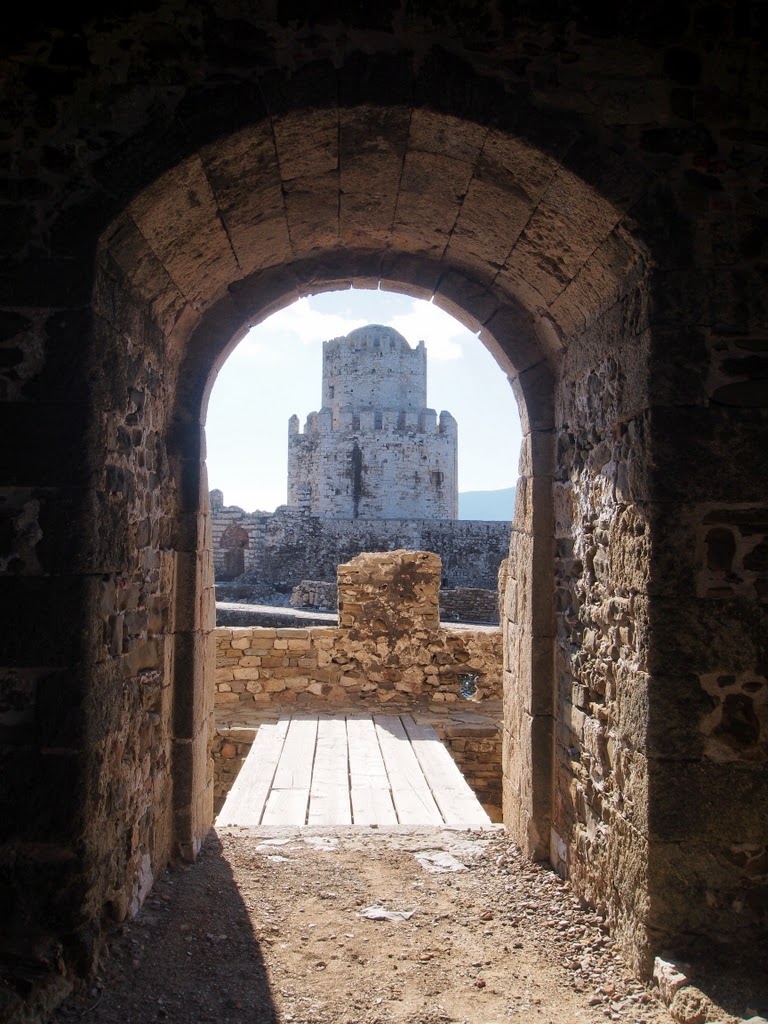| Methoni |
After six weeks here we have been getting a bit stir-crazy. Winter
time in rural Greece is very quiet, apart from the buzzing of chainsaws (a vital piece of olive harvesting equipment). We’ve
walked to the nearest town (Koroni), our local village and supermarket (Harakopio),
down to the beach, and to the other nearby villages. Many times. Though the
scenery is lovely: olive groves, sea, sand, mountains, white houses, and more
olive groves, we’ve felt the need to get out and explore. We have taken the local bus to another nearby
town but it is much the same. Luckily we now have use of a rental car so we put
it to good use last weekend with a drive over to the other side of this peninsular.
 |
| Typical village |
The Peloponnese are mountainous so most of the inland
roads are narrow and very windy. The interior is almost exclusively olive groves.
Very agricultural. So we headed due west across to the other coast, to the village of Methoni.
Now a quick historical interlude … after the fall of the Roman
Empire (which controlled Greece at the time), the Eastern Roman Empire (Byzantine),
out of Constantinople (now Istanbul) took over. They had some control of Greece
until the start of the Crusades, one of which sacked Constantinople. The Europeans
(collectively known as “Franks”) took over parts of the coast to protect their
fleets on the way to the Middle East. The Venetians also arrived to build castles
to protect harbours for their fleets. Then the Turk arrived during the Ottoman
Empire and controlled Greece till the 1820’s when it became independent. Hence most
of the castles dominate ports and were variously built and extended by Franks,
Venetians and Turks.
Koroni and Methoni are “twin” forts, both built by the Venetians
and later enhanced by the Turks. Koroni is impressive but Methoni is magical. It
has the full walls around a peninsula with towers and tunnels to explore, along
with the remains of some old buildings. It is big enough to have contained an
entire town, though the French shifted that inland in the 19th Century.
The walls are very strong with many openings for cannon. At one stage 7,000 Venetians
held out 100,000 Turks until four supply ships arrived. They got so excited (Italians!)
that they rushed to the ships and left the walls, the Turks promptly overran
the fort and butchered everyone.
 |
| Note the three stone cannonballs |
 |
| Nice views - and more olives! |
 |
| Farnkish castle at Navarino Bay |
Also near the top end of the bay is “Nestor’s cave” where many ancient Greek tablets were found dating from Homeric times. There is so much history here in Greece, mostly ancient as it is hard to tell how old the houses and towns are, but there are the various castle remains (13th - 17th Century), the odd Turkish-era well, quite a few old Byzantine churches, and then the really old classical Greek remains.
 |
| Olives arriving at the Mill |
We wandered back home via some very windy roads in the interior
past, you guessed it, mostly olive groves. The locals were out harvesting some
and at one stage we came across a mill which was full of people and their piles
of sacks. A good day out in the mighty little Daihatsu which may, or may not,
have been insured. We ring up when we want the car (it is parked in our drive
all the time) and the rental company are supposed to book insurance for the
day. I suspect they only do it after an accident …
* Note that there are several
different spellings of many place names as there is no direct transliteration from
the Greek alphabet to our Latin one. Our local village is marked on maps as
Harakopio or Charakopio.






No comments:
Post a Comment